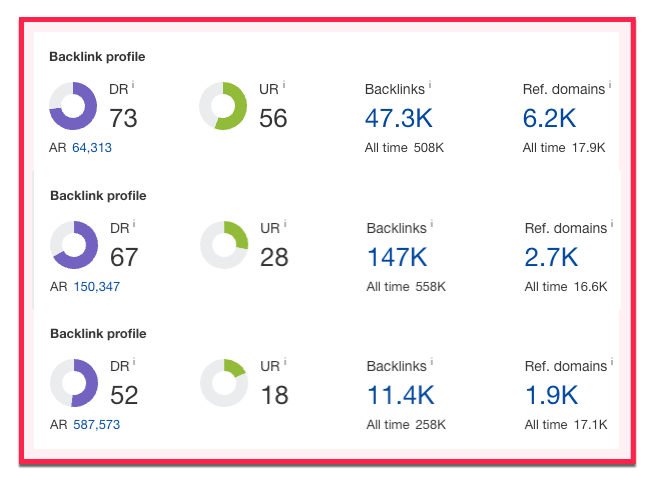Private Blog Networks (PBNs): What Are They & Do They Work?

Hand off the toughest tasks in SEO, PPC, and content without compromising quality
Explore ServicesWe sometimes hear this question from clients: “I see my competitors outranking me with what I suspect are PBN links—should I be considering a similar tactic?”
If this is a question you’ve also been asking yourself, allow us to cut through the noise, explore the potential benefits, and help you decide if PBN links are worth the risk.
What Are Private Blog Networks (PBN) Links?

PBN links are backlinks (inbound links) that originate from Private Blog Networks (PBN) sites. A PBN is a group of websites, usually built on expired domains that, on the surface, look unrelated. However, unbeknownst to search engines like Google (at least that’s the hope), they are all secretly controlled or owned by the same person or company.
The goal is to use these PBN sites to link back to one main website (the “money site”) to boost its authority and potentially catapult it to top rankings for competitive keywords. The owner of the PBN tries to make it look like these are natural links that have been earned organically, not something they’ve orchestrated internally.
PBN Terminology
PBNs have their own terminology that you may come across while digging into the topic. So you don’t get lost, here are some quickfire definitions for you:
- Money sites, as I just mentioned, are the main websites you are trying to boost in the rankings. It’s where they hope to drive traffic and conversions.
- PBN sites are the websites within the network that link back to the money site. There are a few different categories these can fall into:
- Tier 1 PBN sites are usually built on expired domains that already have some authority. They typically have the strongest backlinks, and their primary purpose is to pass link equity to the money site.
- Tier 2+ PBN sites might be built on less authoritative or new domains. They might link directly to the money site, but often, they are used to strengthen the Tier 1 PBNs.
Additional terms you may stumble across:
- Churn and burn refers to a cheap PBN strategy using low-quality sites built on spammy domains. The goal is quick results, with an acceptance that the sites will likely be penalized eventually.
- Shell websites are sometimes used as part of a PBN. They appear to be legitimate businesses but are actually owned by the PBN operator for the sole purpose of linking out.
Why Would Someone Consider a PBN?
Backlinks are among the strongest ranking signals. Google places an immense amount of weight on them. This study found that the top-ranking search result in Google has, on average, 3.8 times more backlinks than those ranked in positions two to ten.
But let’s get real: traditional link-building is often slow and, more often, incredibly frustrating.
Ready to pull your hair out? As a company that specializes in offering link-building services, we can totally relate. You’re doing everything by the books, following Google’s recommendations to a tee, but the results are tedious. You can only take writing so many outreach emails before you feel like you just can’t do it anymore.
Meanwhile, some competitors seem to be getting ahead. Are they using PBNs? I mean, maybe. It can be hard to tell. And there’s no point in denying it: PBN links can sometimes work, even if it is just for short-term gain. If you don’t get caught (and that can be a BIG if), PBN links may boost a web page’s rankings, sending them to the top of the search engine results page (SERP) pile.
Regardless of whether a tactic like this works in the long term or not, just knowing that competitors may be using PBNs no doubt stokes your internal I-have-to-get-results-at-all-costs fire. And I honestly can’t blame you for considering following a similar path. After all, PBNs offer you control of the links, the anchor text, and the pace at which your money site gains authority.
On the surface, it’s the dream.
But, just like traditional link-building, PBNs aren’t without their own set of challenges. Can those short-term gains ever truly be worth the risk? Let’s explore when (if ever) they might make sense.
Understanding the Risks of PBNs
You can probably sense the setup here. You’re sitting here at this point wondering, “Okay, so what’s the catch?” Well, if PBNs could consistently deliver top rankings without consequences, everyone would use them, right?
Let’s start by defining Google’s stance: The search engine claims its algorithms are getting smarter at detecting link schemes like PBNs, and the penalties for getting caught will be devastating. Recovering from penalties is never easy and can cost a significant amount of time and money. Google specifically states that links “intended to manipulate PageRank or a site’s ranking in Google search results may be considered part of a link scheme and a violation of Google’s Webmaster Guidelines.”
What Google is calling out here is that a single penalty can wipe out months, even years, of hard-earned SEO progress for your money site. In the worst cases, your site may never fully recover.
Doom and gloom, I know. Just don’t shoot the messenger. Remember, PBNs sometimes seem to work, at least for a while. It’s a gamble.
Here’s an example of when PBNs have gone wrong. I recently watched this video. In it, an experienced SEO, Keith Bresee, who does consultancy work for big-ticket clients like Dr. Axe, Dave Ramsey, Manscaped, Remax, and Southwestern Consulting, details his outlook on content creation and SEO as a whole.
I’m paraphrasing here, but Keith says he reserves black and grey-hat tactics for his own site, not his clients’, treating his own site as somewhat of a crash dummy site. He used PBNs, and a massive traffic drop suggests Google caught on. Keith says, “I did a bunch of PBN links…so I tanked it.” Before Keith tanked the site, it received around 18,000 visitors a month. Now, he claims around 2,200.
This time, it appears, the gamble didn’t pay off.
When Might PBNs Work?
Don’t get me wrong, there are some scenarios where PBN links might deliver results. A brand-new site in a low-competition niche, for instance, could see a boost. Or, if you’re facing a sudden Google penalty unrelated to links and need a fast (though risky) way to regain visibility while you fix the underlying issue, PBN links may be something you consider turning to.
I mean, there are multiple conversations online discussing this very outcome. Take these comments from Reddit, for example. In r/bigseo, OP’s post reads:

One Redditer replying to OP’s post says:

And another:

But there’s a chance the scenarios outlined in this Reddit discussion are the exceptions, not the rule. Not to mention, at the time of writing, these comments were made four years ago. Google’s algorithms move quickly. When it comes to SEO, the whole game can change overnight. Four years ago might as well be the Jurassic Period.
So, the crux of the argument is: Are PBNs “worth it”?
Before even considering PBNs, you have to do a brutally honest cost-benefit analysis. Keep this in mind: just like traditional link-building, maintaining an effective PBN requires time and investment. You need to constantly find new expired domains, create decent content to avoid raising suspicion and keep the technical side hidden from Google. That’s time and money that could be spent on sustainable link-building strategies.
Even if you do see a temporary rankings boost, is it worth the constant fear of discovery? And what’s the long-term plan? As highlighted by this study and underscored by SEOPub’s above Reddit comment, top-ranking posts attract far more natural backlinks than lower-ranking posts. The dream scenario for a PBN scheme is to artificially inflate a web page’s rankings with PBN links to attract those natural backlinks. Once those are in place, you could gamble on removing the PBN links, hoping the legitimate backlinks will be enough to maintain its position. But there’s no guarantee this will work. Not to mention, the stakes are high. Get caught, and you’ll be in Keith Bresee’s shoes, having to work your way up from the bottom all over again.
Sustainable Alternatives to PBNs
If, after weighing the risks, you decide that PBNs aren’t worth the gamble, you’re in good company. There are far safer, more sustainable, low-risk ways to build a strong backlink profile. Sure, they aren’t as glamorous as PBNs, but you eliminate the risk of your site’s traffic and revenue getting blindsided by a future Google algorithm update.
Think of strategies like guest posting, HARO outreach, and producing data-driven original research that other sites want to reference. Good examples of original research are the studies that I’ve linked to here on this very web page. Their insights helped me back up my words with numbers. You can provide similar value by conducting surveys and case studies that demonstrate unique angles and talking points not found anywhere else.
Sure, this approach takes effort. It takes time to see results. There’s no shortcut to the top with white-hat SEO. But unlike the potential crash-and-burn of PBNs, the benefits of these strategies compound over time. Sure, PBNs might be a fast track, but site owners who are investing in sustainable strategies are building a lasting advantage.
As your site attracts those natural, high-quality links, your rankings become more stable and less vulnerable to a Google manual action. And unlike PBNs, where those costs and risks are ongoing, the return on investment for strategies like guest posting, HARO outreach, and other white-hat link-building tactics increases over time.
The backlinks you are looking for 👀
Loganix manually-build in-content links from niche-specific sites with at least 1,000 organic visits/mo, stable histories, and strong metrics. We call them authority links.

Conclusion
Okay, full circle here—I get it. The frustration is real. Backlink building can be incredibly difficult. It’s easy to see why someone—potentially like yourself—who’s facing unanswered emails and unresponsive clients might feel tempted to take matters into their own hands, even with the risks involved.
But remember: the potential gains from PBNs can be short-lived, and the tactic comes with significant risk. Building a website that stands the test of time, one that ranks well requires the right approach.
That’s where Loganix excels. We understand that every business has unique needs. It’s why we offer a wide range of white-hat link-building services, including press releases, HARO outreach, and more.
🚀 If you’re looking to do things the sustainable way, head to our link-building page to get started. 🚀
Hand off the toughest tasks in SEO, PPC, and content without compromising quality
Explore ServicesWritten by Brody Hall on March 14, 2024
Content Marketer and Writer at Loganix. Deeply passionate about creating and curating content that truly resonates with our audience. Always striving to deliver powerful insights that both empower and educate. Flying the Loganix flag high from Down Under on the Sunshine Coast, Australia.





